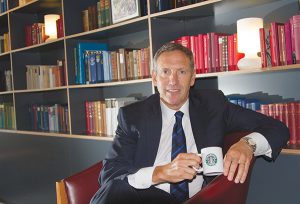Howard Schultz is the Tom Brady of the consumer world.
Starbucks said that Chief Executive Officer Kevin Johnson would retire and that Schultz, who stepped down as CEO for a second time in 2017 and left the company a year later, would return as interim CEO early next month.
The company’s shares rose as much as 8% as investors welcomed Schultz’s return. After all, it’s hard to overstate the role he played in transforming Starbucks from a boutique coffeehouse to a global dining juggernaut.
But the shareholder reaction is at odds with what seems an unnecessarily convoluted succession planning process, one that could potentially make it harder for Starbucks to recruit a high-caliber CEO to steer it through what could be its most challenging conditions in a decade.
Johnson said he had signalled to the board a year ago that as the pandemic neared an end, he would consider retiring. Starbucks has already begun the search for a successor and expects to name a new CEO by the fall. He will also stay on as a consultant until September, indicating this was a planned transition.
The company says the arrangement gives it more time to find the right leader. With Schultz at the helm, it will be under no pressure to make a quick decision. But Johnson could just as easily have stuck around in the CEO role six months longer to hand over to his successor without Schultz needing to get involved.
Stepping back into the fray creates the impression that he just can’t stay away. He will also be involved with the search and help to settle in the new CEO.
“When you love something, you have a deep sense of responsibility to help when called,†he said.
Coming into a business with such a strong founder culture can be daunting enough for potential CEOs, and that is even more so with Schultz, who was the architect of the Starbucks brand and its growth story. Popping back periodically, and having a hand in the choice of leader, only reinforces the impression that the longtime executive can’t let go. That’s hardly conducive to recruiting top-notch talent.
And right now, Starbucks needs a strong leader. After navigating the pandemic, the company faces a much tougher consumer climate as customers in much of the world feel their incomes squeezed by rising fuel and food prices. Starbucks is grappling with how to raise prices to cover its own escalating costs — for labour, for example — without pricing its customers out of their morning lattes.
—Bloomberg
 The Gulf Time Newspaper One of the finest business newspapers in the UAE brought to you by our professional writers and editors.
The Gulf Time Newspaper One of the finest business newspapers in the UAE brought to you by our professional writers and editors.
